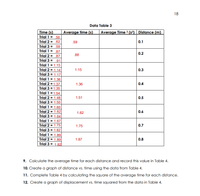
College Physics
11th Edition
ISBN: 9781305952300
Author: Raymond A. Serway, Chris Vuille
Publisher: Cengage Learning
expand_more
expand_more
format_list_bulleted
Question
How do I calculate average time squared?

Transcribed Image Text:18
Data Table 3
Time (s)
Trial 1 = .56
Average time (s)
Average Time 2 (s²) Distance (m)
Trial 2 = .62
.59
0.1
Trial 3 =
.59
Trial 1 = 87
Trial 2 = .87
Trial 3 =
0.2
.88
.91
Trial 1 = 1.15
Trial 2 = 1.14
Trial 3 = 1.17
Trial 1 = 1.36
Trial 2 = 1.37
Trial 3 = 1.35
Trial 1 = 1.54
Trial 2 = 1.48
Trial 3 = 1.50
Trial 1 = 1.60
Trial 2 = 1.62
Trial 3 = 1.64
Trial 1 = 1.67
1.15
0.3
%3D
1.36
0.4
1.51
0.5
1.62
0.6
%3D
Trial 2 = 1.75
Trial 3 = 1.82
1.75
0.7
%3D
Trial 1 = 1.89
Trial 2 = 1.89
Trial 3 = 1.82
%3D
1.87
0.8
9. Calculate the average time for each distance and record this value in Table 4.
10. Create a graph of distance vs. time using the data from Table 4.
11. Complete Table 4 by calculating the square of the average time for each distance.
12. Create a graph of displacement vs. time squared from the data in Table 4.
Expert Solution
This question has been solved!
Explore an expertly crafted, step-by-step solution for a thorough understanding of key concepts.
This is a popular solution
Trending nowThis is a popular solution!
Step by stepSolved in 2 steps with 2 images

Knowledge Booster
Learn more about
Need a deep-dive on the concept behind this application? Look no further. Learn more about this topic, physics and related others by exploring similar questions and additional content below.Similar questions
- Jake’s height is measured to be 67 ???ℎ??; Enrique’s height is measured as 67.2 ???ℎ??. Can we use these two measurements to determine who is taller? Use your understanding of approximate numbers to explain why or why not.arrow_forwardCould you explain why 2.5 is the correct answer ?arrow_forwardA common unit for speed used in sailing is the knot (nautical miles per hour). A nautical mile is about 1.15 regular miles. Calculate how much further (in feet) a boat moving at 22 knots will travel in 5 minutes compared to a car moving at 22 mph during the same time.arrow_forward
- The graph below illustrates a driving trip from the town of Goodfield to the town of Peoria. distance (in miles) 35 30 25 20 15 10 5 0 0 0.25 0.5 0.75 1 time (in hours) (a) How far apart are the two towns? miles (b) Find the slope of the linear graph. select units (c) What does the shape of the graph tell us about the trip? ---Select---arrow_forwardSuppose your speedometer has an uncertainty of 4.5 km/h at a speed of 92 km/h. If the speedometer has the same percent uncertainty when it reads 55 km/h, what is the highest speed, in kilometers per hour, that you might be going? If the speedometer has the same percent uncertainty when it reads 55 km/h, what is the lowest speed, in kilometers per hour, that you might be going?arrow_forwardEstimate the number of steps you would have to take to walk a distance equal to the circumference of the Earth. (We estimate that the length of a step for an average person is about 18 inches, or roughly 0.5 m. The radius of the Earth is 6.38 x 106 m.) 105 steps 108 steps 1011 steps 1015 steps O 1020 stepsarrow_forward
- A person's height is approximately 5 feet 2 inches. Express this height in the following terms. (a) meters m (b) centimeters cmarrow_forwardbn nas set his GPS to track his route. At the end of his hike, his GPS indicates that he walked 3.50 miles north, 1.00 miles at 45 degrees north of east, and 1.50 miles south. How far away is Bill from his starting position? And in what direction is he? Provide the direction in number of degrees in reference to the cardinal directions (North of East, South of West, etc.).arrow_forwardYou are driving 52 mi/h and take your eyes off the road for "just a second" (exactly one second). What distance (in feet) do you travel in this time?arrow_forward
arrow_back_ios
arrow_forward_ios
Recommended textbooks for you
 College PhysicsPhysicsISBN:9781305952300Author:Raymond A. Serway, Chris VuillePublisher:Cengage Learning
College PhysicsPhysicsISBN:9781305952300Author:Raymond A. Serway, Chris VuillePublisher:Cengage Learning University Physics (14th Edition)PhysicsISBN:9780133969290Author:Hugh D. Young, Roger A. FreedmanPublisher:PEARSON
University Physics (14th Edition)PhysicsISBN:9780133969290Author:Hugh D. Young, Roger A. FreedmanPublisher:PEARSON Introduction To Quantum MechanicsPhysicsISBN:9781107189638Author:Griffiths, David J., Schroeter, Darrell F.Publisher:Cambridge University Press
Introduction To Quantum MechanicsPhysicsISBN:9781107189638Author:Griffiths, David J., Schroeter, Darrell F.Publisher:Cambridge University Press Physics for Scientists and EngineersPhysicsISBN:9781337553278Author:Raymond A. Serway, John W. JewettPublisher:Cengage Learning
Physics for Scientists and EngineersPhysicsISBN:9781337553278Author:Raymond A. Serway, John W. JewettPublisher:Cengage Learning Lecture- Tutorials for Introductory AstronomyPhysicsISBN:9780321820464Author:Edward E. Prather, Tim P. Slater, Jeff P. Adams, Gina BrissendenPublisher:Addison-Wesley
Lecture- Tutorials for Introductory AstronomyPhysicsISBN:9780321820464Author:Edward E. Prather, Tim P. Slater, Jeff P. Adams, Gina BrissendenPublisher:Addison-Wesley College Physics: A Strategic Approach (4th Editio...PhysicsISBN:9780134609034Author:Randall D. Knight (Professor Emeritus), Brian Jones, Stuart FieldPublisher:PEARSON
College Physics: A Strategic Approach (4th Editio...PhysicsISBN:9780134609034Author:Randall D. Knight (Professor Emeritus), Brian Jones, Stuart FieldPublisher:PEARSON

College Physics
Physics
ISBN:9781305952300
Author:Raymond A. Serway, Chris Vuille
Publisher:Cengage Learning

University Physics (14th Edition)
Physics
ISBN:9780133969290
Author:Hugh D. Young, Roger A. Freedman
Publisher:PEARSON

Introduction To Quantum Mechanics
Physics
ISBN:9781107189638
Author:Griffiths, David J., Schroeter, Darrell F.
Publisher:Cambridge University Press

Physics for Scientists and Engineers
Physics
ISBN:9781337553278
Author:Raymond A. Serway, John W. Jewett
Publisher:Cengage Learning

Lecture- Tutorials for Introductory Astronomy
Physics
ISBN:9780321820464
Author:Edward E. Prather, Tim P. Slater, Jeff P. Adams, Gina Brissenden
Publisher:Addison-Wesley

College Physics: A Strategic Approach (4th Editio...
Physics
ISBN:9780134609034
Author:Randall D. Knight (Professor Emeritus), Brian Jones, Stuart Field
Publisher:PEARSON